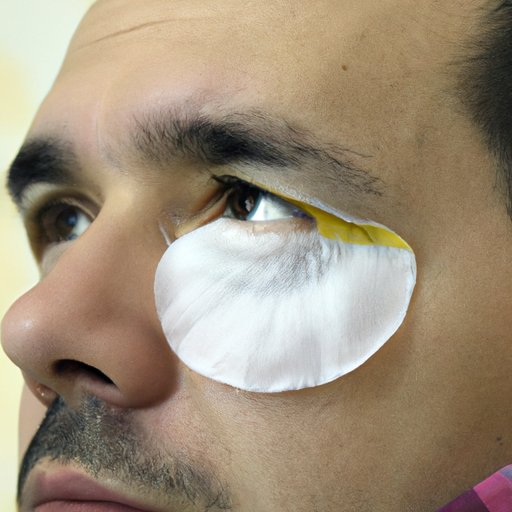
Introduction
Styes can be a painful and irritating eye condition that can affect anyone at any age. These small, red bumps that appear on the eyelids can cause discomfort and can make you feel self-conscious. Fortunately, with proper hygiene practices and timely medical attention, you can manage styes easily. This article will provide a comprehensive overview of styes, their causes, symptoms, risk factors, and preventive measures.
Exploring the Science Behind Styes: What Causes Them and Why Do We Get Them?
A stye, also known as a hordeolum, is a small abscess that forms on the eyelid. It occurs when an oil gland or eyelash follicle becomes infected with bacteria such as Staphylococcus aureus. Blocked oil glands can also lead to the formation of styes. Poor hygiene habits, such as rubbing your eyes, touching your face with dirty hands, and not washing your face regularly, can increase the risk of bacterial infections and stye formation.
Several risk factors increase the likelihood of stye formation, including age, pre-existing medical conditions such as blepharitis (an inflammation of the eyelids), and wearing contact lenses. Additionally, children are more prone to developing styes because they may not be as hygienic and often have a weaker immune system.
The Eyes Have It: Tips to Prevent and Treat Styes
The best way to prevent styes from forming is to practice good hygiene habits. Be sure to wash your face and hands regularly, refrain from touching your eyes with dirty hands, and avoid sharing personal items like towels or costumes with others. It’s also essential to remove your makeup before going to bed, so your hair follicles and oil glands don’t get blocked.
If you do develop a stye, several home remedies can help alleviate the discomfort. Applying a warm compress to your eye can help open up blocked oil glands and promote drainage. Tea tree oil and turmeric can also help fight off bacteria and reduce swelling. Over-the-counter treatments, including antibiotic ointments and pain relievers, can provide relief for mild cases of styes. However, severe styes that don’t respond to home remedies require medical attention.
Styes 101: A Comprehensive Guide to Understanding and Managing Styes
A stye usually appears as a red, painful bump on the edge or inside the eyelid. It can take a few days to develop fully and may cause swelling of the eyelid. There are two primary types of styes: hordeolum and chalazion. Hordeolum appears on the edge of the eyelid, while chalazion forms in the inside of the eyelid. Both can be painful and cause discomfort.
Persistent and untreated styes can lead to complications such as the spread of infection to other parts of the eye, including the cornea. If you have a stye that doesn’t go away after a week or that recurs frequently, it’s essential to seek medical attention promptly. An ophthalmologist or optometrist can recommend the appropriate treatment, including antibiotic eye drops or ointments or even surgical removal of the stye.
Stye Infection: Causes, Symptoms and Home Remedies
An untreated stye can lead to a stye infection, which is a more severe condition. Bacterial infections often result from stye formation, and the symptoms can include redness, yellowish discharge, soreness, and swelling around the eyelid. If left untreated, the infection can spread to other parts of the eyes, causing complications like conjunctivitis or cellulitis.
Several home remedies can help reduce the symptoms of stye infections. Applying a warm compress to the affected area for about ten minutes, several times a day, can help promote drainage and relieve pain. You can also use a saline solution to clean your eye and keep it bacteria-free. However, if the infection persists for more than a week, it’s essential to seek medical attention promptly.
Don’t Let Styes Keep You Down: A Guide to Quick Relief and Prevention
If you’re looking for quick relief from the pain and discomfort associated with styes, there are several simple methods you can try. Applying a warm compress to the affected area, using antibiotic creams or over-the-counter pain relief medications, and maintaining proper hygiene habits can help alleviate pain and reduce swelling.
Preventive measures are essential to reduce the risk of stye formation. Avoid sharing personal items in public places, including towels and mascara. Be sure to wash your hands and face regularly, avoid touching your eyes, and remove your makeup before going to bed. Wearing protective eyewear like goggles when swimming or playing sports can also help protect your eyes from bacteria and other harmful substances.
Finally, if you have a persistent stye or signs of an infection, seek medical help promptly. Your ophthalmologist or optometrist can diagnose and treat the underlying cause of your stye and help prevent the formation of future ones.
The Lowdown on Styes: Understanding the Symptoms and Causes
To summarize, styes are a painful and irritating eye condition caused by bacterial infections or blocked oil glands. Good hygiene habits, timely medical attention, and simple home remedies can help manage styes and reduce the risk of complications. Recognizing the symptoms of styes and following preventive measures can help you maintain healthy eye hygiene and prevent styes from disrupting your daily life.
Clear Vision with No Styes: A Guide to Managing These Eyelid Infections
In conclusion, styes can be a painful but manageable eye condition. With the right hygiene practices, preventive measures, and medical attention, you can reduce your risk of styes and find relief from the discomfort they cause. It’s essential to recognize the symptoms of styes, seek medical attention promptly, and maintain proper eye hygiene habits to keep your eyes healthy and stye-free.




